
Retaining its vibrant green hue from infancy to maturity, amot closely resembles coffee or conventional pepper. Each amot tree yields between 8 to 12 kilograms of pepper seeds annually.
The tree trunk itself emits the same enticing aroma as the seeds, prompting many locals to peel the bark for use as a spice. After harvesting, the pepper seeds are dried and stored in gourd shells or bamboo tubes, tightly sealed to preserve their fragrance.
Placed near the hearth in the kitchen, amot can be stored year-round without losing its aromatic essence.
Amot can be incorporated directly into dishes during cooking to impart its distinctive flavor, used to concoct dipping sauces, or ground into a flavorful salt for fish dishes, effectively neutralizing any fishy odor while enhancing the dish’s overall taste.
Unlike chili or conventional pepper, amot offers a milder heat profile, boasting an aroma reminiscent of lemon leaves intertwined with lemongrass, with hints of grapefruit leaves and tangerine peel.
In modern times, amot has become a ubiquitous ingredient in dishes served at local restaurants and eateries, infusing the air with the fragrant essence of the Quang Nam highlands. Moreover, young individuals venturing beyond their native region often carry tubes of amot with them, serving not only as a culinary enhancer but also as a symbol of home and a tangible link to their cultural heritage and culinary traditions.
Saigon Times